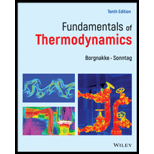
Fundamentals Of Thermodynamics
10th Edition
ISBN: 9781119494966
Author: Borgnakke, C. (claus), Sonntag, Richard Edwin, Author.
Publisher: Wiley,
expand_more
expand_more
format_list_bulleted
Question
error_outline
This textbook solution is under construction.
Students have asked these similar questions
5- Nitrogen gas flows into a convergent nozzle at 200 kPa, 400 K and very low velocity. It flows out of the
nozzle at 100 kPa, 330 K. If the nozzle is insulated, find the exit velocity.
a- 222 m/s
b- 382 m/s
c- 512 m/s
d- 640 m/s
AU-0 means that the process is isothermal?
This question is about vapor nozzle
Due to a failure, ammonia in a large container overheats to 1400 kPa, 573 K. At this state, a small crack opens in the container that acts as a nozzle. The outside environment is at 100 kPa, 298 K, and the mass flow rate of ammonia is 10 g/s . Assume negligible nozzle inlet velocity and adiabatic reversible flow. Determine the exit velocity, and the exit cross section.
K)
that undergo an
K-K
13. There are 1.5 Kgof a gas where K = 1.3 and R = 0.38
tsochoric process from pi = 0.552 MPa, t, = 58.5°C top2 = 1.66 MPa. During the
process, there added 100 KJ of heat. Compute the heat transferred, change of
internal energy and the change of entropy.
%3D
Knowledge Booster
Learn more about
Need a deep-dive on the concept behind this application? Look no further. Learn more about this topic, mechanical-engineering and related others by exploring similar questions and additional content below.Similar questions
- Low-velocity steam with negligible kinetic energy enters a nozzle at 320°C, 3 MPa. The steam leaves the nozzle at 2 MPa with a velocity of 410 m/s. The mass flow rate is 0.37 kg/s. Find the following:a. Determine the exit state.b. Determine the exit area.arrow_forwardplease answer all with complete solution, thank youu.arrow_forwardA turbine operating in a continuous flow works adiabatically. The water vapor enters the turbine at a temperature of 650 C and comes out with 20 kPa pressure and 85% dryness. Find the mass flow rate (kg / sec) required to generate 10 MW of power from the system (ignore KE and PE changes)arrow_forward
- Air at the rate of 14kg/sec expands from 3bar, 1500C, 0.1m3 to 1 bar reversibly and adiabatically. Find the exit temperature and power developed. If the heat is given to the system 1200J. Find out the change in internal energyarrow_forwardProblem 8 Calculate the change in the entropies of the system (AS.99) and the surroundings (ASsur), and the total entropy change (ASotal) when a sample of 1.0 mol of an ideal gas at 300 K and 1.0 bar triples its volume in: a) isothermal reversible expansion b) isothermal expansion against a vacuum (Psurr = 0) c) Will the process in (a) occur spontaneously? What about the process in (b)? Why or why not? %3Darrow_forwardA 5 m3rigid tank has propane at 500 kPa, 700 K and connected by a valve to another tank of 0.7 m3with propane at 350 kPa, 600 K. The valve is opened and the two tanks come to a uniform state at 350 K. What is the final pressure?For propane R = 0.1886 kJ/kgKarrow_forward
- Water Vapor pressure 8 MPa and 350 in an adiabatic turbineIt enters at a temperature of oC and at a pressure of 750 kPacomes out. Reversible The amount of work done by the unit mass of steam for the processcalculate.arrow_forwardSolve it correctly please. I will rate. Answer should be matcharrow_forward3. An adiabatic compressor takes argon from 100 kPa, 300 K to 2000 kPa. The compressor efficiency is 80%. (a) Find the outlet temperature (K) and the work (kJ/kg) (b) Find the entropy generation (kJ/kg-K)arrow_forward
- Please show your complete solution. Thank you! During the reversible process executed by the non-flow system, the pressure increases 334.79 kPa to 1378.96 kPa in accordance with PV=C and the internal energy increase is 22, 577 J, the initial volume is 85 liters. Find the heat.arrow_forwardThere are required 2000 kW of compressor power to handle air adiabaticallyfrom 1 atmosphere, 27 oC, to 305 kPaa. The initial air velocity is 20 m/s and the finalvelocity is 85 m/s. a) If the compression is isentropic, find the compressor capacity, inm3/s. b) If the compression process is irreversible adiabatic to a temperature of 160 oC,with the capacity found in c), determine the compressor power input, in Hp.arrow_forwardcan you write all steps ,and what you use (chart) be hurry pleasearrow_forward
arrow_back_ios
SEE MORE QUESTIONS
arrow_forward_ios
Recommended textbooks for you
 Elements Of ElectromagneticsMechanical EngineeringISBN:9780190698614Author:Sadiku, Matthew N. O.Publisher:Oxford University Press
Elements Of ElectromagneticsMechanical EngineeringISBN:9780190698614Author:Sadiku, Matthew N. O.Publisher:Oxford University Press Mechanics of Materials (10th Edition)Mechanical EngineeringISBN:9780134319650Author:Russell C. HibbelerPublisher:PEARSON
Mechanics of Materials (10th Edition)Mechanical EngineeringISBN:9780134319650Author:Russell C. HibbelerPublisher:PEARSON Thermodynamics: An Engineering ApproachMechanical EngineeringISBN:9781259822674Author:Yunus A. Cengel Dr., Michael A. BolesPublisher:McGraw-Hill Education
Thermodynamics: An Engineering ApproachMechanical EngineeringISBN:9781259822674Author:Yunus A. Cengel Dr., Michael A. BolesPublisher:McGraw-Hill Education Control Systems EngineeringMechanical EngineeringISBN:9781118170519Author:Norman S. NisePublisher:WILEY
Control Systems EngineeringMechanical EngineeringISBN:9781118170519Author:Norman S. NisePublisher:WILEY Mechanics of Materials (MindTap Course List)Mechanical EngineeringISBN:9781337093347Author:Barry J. Goodno, James M. GerePublisher:Cengage Learning
Mechanics of Materials (MindTap Course List)Mechanical EngineeringISBN:9781337093347Author:Barry J. Goodno, James M. GerePublisher:Cengage Learning Engineering Mechanics: StaticsMechanical EngineeringISBN:9781118807330Author:James L. Meriam, L. G. Kraige, J. N. BoltonPublisher:WILEY
Engineering Mechanics: StaticsMechanical EngineeringISBN:9781118807330Author:James L. Meriam, L. G. Kraige, J. N. BoltonPublisher:WILEY

Elements Of Electromagnetics
Mechanical Engineering
ISBN:9780190698614
Author:Sadiku, Matthew N. O.
Publisher:Oxford University Press

Mechanics of Materials (10th Edition)
Mechanical Engineering
ISBN:9780134319650
Author:Russell C. Hibbeler
Publisher:PEARSON

Thermodynamics: An Engineering Approach
Mechanical Engineering
ISBN:9781259822674
Author:Yunus A. Cengel Dr., Michael A. Boles
Publisher:McGraw-Hill Education

Control Systems Engineering
Mechanical Engineering
ISBN:9781118170519
Author:Norman S. Nise
Publisher:WILEY

Mechanics of Materials (MindTap Course List)
Mechanical Engineering
ISBN:9781337093347
Author:Barry J. Goodno, James M. Gere
Publisher:Cengage Learning

Engineering Mechanics: Statics
Mechanical Engineering
ISBN:9781118807330
Author:James L. Meriam, L. G. Kraige, J. N. Bolton
Publisher:WILEY
Power Plant Explained | Working Principles; Author: RealPars;https://www.youtube.com/watch?v=HGVDu1z5YQ8;License: Standard YouTube License, CC-BY